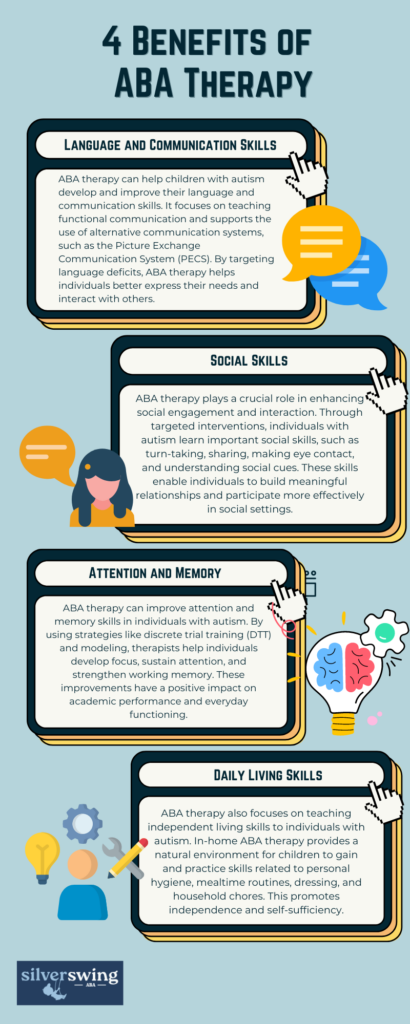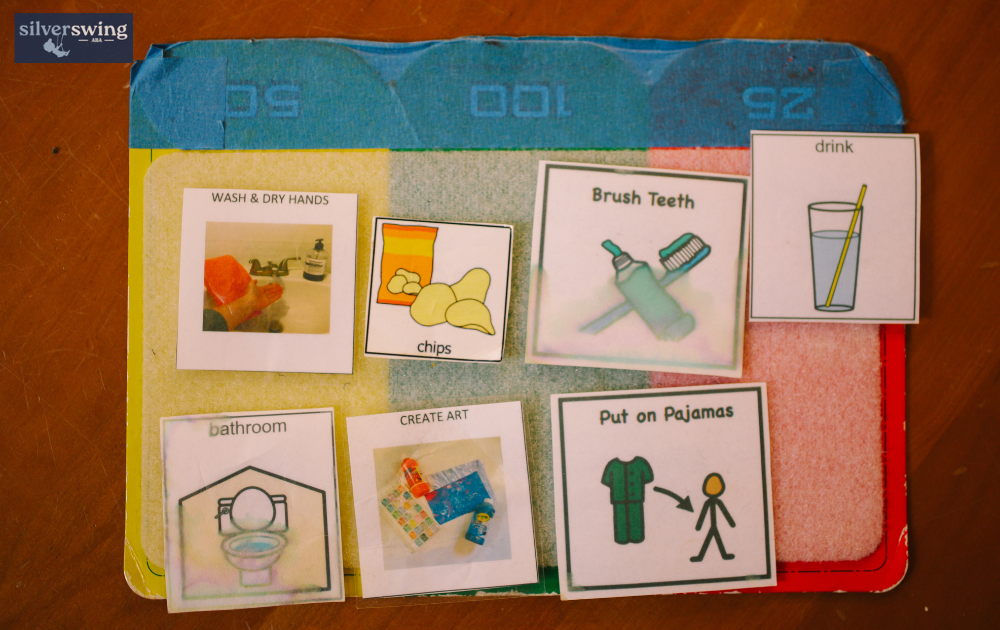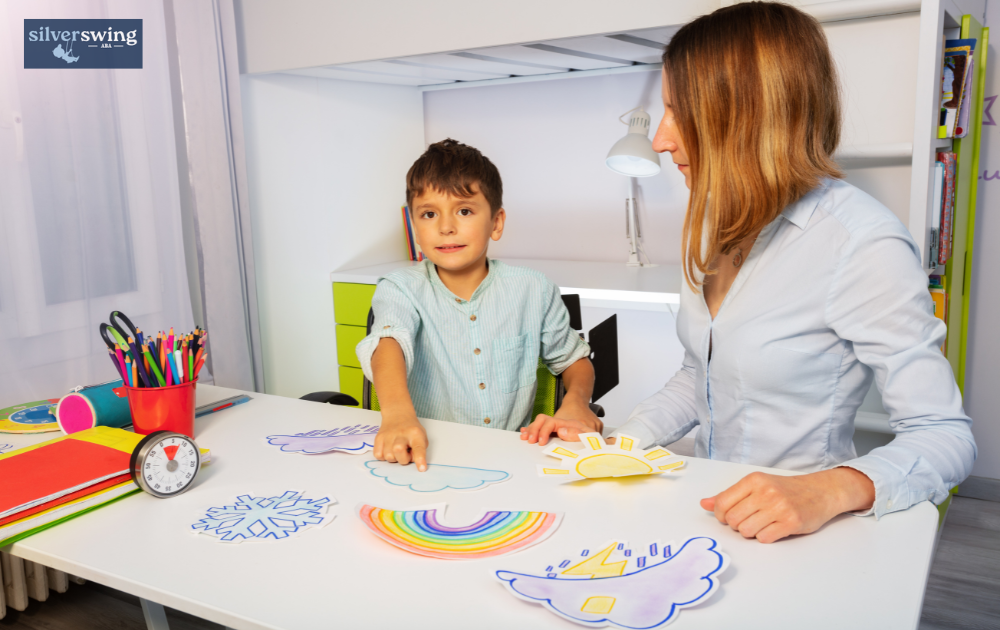Applied Behavior Analysis (ABA) therapy is an evidence-based treatment approach that has been widely recognized for its effectiveness in individuals with autism spectrum disorder (ASD). ABA therapy targets various areas to improve the quality of life for those receiving the intervention. It focuses on understanding and modifying behaviors to promote positive changes and build essential skills.
What is ABA Therapy?
ABA therapy is a comprehensive approach that involves assessing the unique needs of each individual and designing interventions tailored to their specific challenges and strengths. The therapy utilizes the principles of behavior analysis to understand how behaviors are influenced by environmental factors, and it seeks to modify behavior to achieve meaningful outcomes.
ABA therapists work closely with individuals with autism to identify target behaviors and develop strategies to address them. These strategies are based on the principles of reinforcement, prompting, shaping, and fading, among others. The goal is to promote positive behaviors, reduce challenging behaviors, and enhance skills across various domains, including communication, social interaction, academics, and daily living.
Benefits of ABA Therapy
The benefits of ABA therapy for individuals with autism are extensive. Research has consistently shown that ABA therapy can lead to significant improvements in various areas of development and functioning. Some of the key benefits include:

By working closely with trained ABA therapists, individuals with autism and their families can experience the numerous benefits of ABA therapy. ABA therapy activities at home, combined with in-clinic sessions, offer a comprehensive approach to support skill development and improve overall functioning.
Common ABA Therapy Techniques
There are several ABA therapy techniques that have proven to be effective in helping individuals with autism develop social, communication, and behavioral skills. In this section, we will explore three common ABA techniques: Discrete Trial Training (DTT), Picture Exchange Communication System (PECS), and Modeling.
Discrete Trial Training (DTT)
Discrete Trial Training (DTT) is a widely used technique in ABA therapy for individuals with autism. It involves one-on-one sessions in a controlled environment, where the therapist breaks down skills or behaviors into smaller, more manageable steps. During a DTT session, the therapist provides prompts, asks for the desired behavior, and rewards the behavior with positive reinforcement.
The structured nature of DTT allows for repeated practice and reinforcement of specific skills, such as following instructions, imitating actions, or responding to questions. This technique helps individuals with autism learn new skills and generalize them to different settings and situations.

Picture Exchange Communication System (PECS)
The Picture Exchange Communication System (PECS) is a widely used ABA therapy technique that focuses on developing communication and vocabulary skills, particularly in children with autism. PECS utilizes a system of pictures to facilitate communication.
During PECS sessions, individuals are taught to exchange pictures of desired objects or activities in exchange for the actual objects. This helps to build communication skills by associating pictures with words or phrases. Over time, individuals learn to use the pictures to make requests, comment, and engage in social interactions.
PECS is a valuable tool for individuals who struggle with verbal communication, as it provides a visual and structured way to express their needs and wants. It promotes the development of language skills and can be expanded to include more complex communication concepts.
Modeling
Modeling is an essential technique in ABA therapy that involves the therapist demonstrating the desired behavior to the individual. This can be done in-person, through video examples, or audio recordings. Modeling helps individuals with autism learn social and communication skills by observing and imitating the behavior demonstrated by the therapist.
By seeing the behavior modeled, individuals learn how to engage in specific actions, such as shaking hands, using polite language, or saying thank you. Modeling can be particularly helpful for individuals who have difficulty understanding verbal instructions or social cues. It provides a visual reference and helps individuals learn appropriate behaviors in a concrete and structured manner.
Through the use of these common ABA therapy techniques, individuals with autism can make significant progress in developing essential skills. Each technique offers unique benefits and can be tailored to the individual’s needs and goals.

Implementing ABA Therapy at Home
For individuals with autism, implementing ABA therapy at home can be a valuable complement to formal therapy sessions. This section will explore ABA activities for home, strategies for parents, and the importance of early intervention.
ABA Activities for Home
In-home ABA therapy provides a natural environment for children to gain and practice skills. ABA activities at home can include a wide range of tasks that help children learn new skills and expand their vocabulary. Some examples of ABA therapy activities that can be incorporated into the home environment include:
- Sorting numbers, colors, and different emotions
- Completing puzzles and matching games
- Engaging in pretend play scenarios
- Following simple instructions and routines
- Practicing turn-taking and sharing
Incorporating these activities into daily routines can help parents create opportunities for their child to learn and reinforce skills in a familiar and comfortable setting. Remember to tailor activities to your child’s interests and abilities to maintain motivation and engagement.

Strategies for Parents
Parents play a crucial role in supporting their child’s progress in ABA therapy. Here are some strategies parents can employ when implementing ABA therapy at home:
- Consistency and Structure: Establish consistent routines and schedules to provide a structured environment that promotes learning and reduces anxiety.
- Reinforcement: Use positive reinforcement techniques, such as praise, rewards, and tokens, to reinforce desired behaviors and encourage progress.
- Visual Supports: Incorporate visual supports, such as visual schedules and social stories, to enhance communication and understanding.
- Communication: Foster open communication with therapists to ensure alignment in goals and strategies. Regularly share observations and progress updates to optimize therapy effectiveness.
- Self-Care: Take care of your own well-being. ABA therapy can be intensive, and it’s important for parents to prioritize self-care, seek support, and take breaks when needed.
ABA Therapy Strategies
When it comes to implementing effective ABA therapy, several strategies can be utilized to address behavioral challenges and promote positive outcomes for individuals with autism. In this section, we will explore three key ABA therapy strategies: the Antecedent-Behavior-Consequence (ABC) approach, tailoring ABA strategies, and using everyday items for activities.
Antecedent-Behavior-Consequence (ABC) Approach
The Antecedent-Behavior-Consequence (ABC) approach is a fundamental technique used in ABA therapy to target and improve specific behaviors. This approach involves analyzing the events that occur before (antecedent), during (behavior), and after (consequence) a behavior. By understanding the ABCs of a behavior, therapists and caregivers can identify patterns and implement strategies to modify and shape behavior.
Using the ABC approach, therapists and caregivers observe and document behaviors, paying close attention to the antecedents that trigger the behavior and the consequences that follow. This information helps in identifying potential triggers and understanding the function or purpose of the behavior. By modifying antecedents and consequences, therapists and caregivers can promote positive behaviors and reduce challenging ones.
Tailoring ABA Strategies
Each individual with autism is unique, and ABA therapy strategies should be tailored to meet their specific needs. Tailoring strategies involves considering the individual’s strengths, interests, and preferences to create an engaging and motivating learning environment.
By incorporating the individual’s interests into therapy activities, therapists and caregivers can increase motivation and participation. For example, if a child has a particular interest in cars, therapy activities can incorporate car-themed materials or concepts to maintain engagement and foster learning.
Additionally, the pace and complexity of ABA strategies should be adjusted according to the individual’s abilities. Starting with achievable goals and gradually increasing the level of difficulty ensures that the individual can experience success and build upon their skills. This individualized approach helps to maximize progress and promote positive outcomes.

Using Everyday Items for Activities
ABA therapy activities can be implemented at home using everyday items, making it easier for parents and caregivers to reinforce positive behaviors and skills.
For example, parents can use different baskets to have their child sort toys by matching them with the correct color baskets. This activity promotes color recognition, sorting skills, and following directions. By using familiar objects and incorporating them into therapy activities, learning becomes more tangible and relevant.
Using everyday items not only makes therapy activities more accessible but also enhances generalization. Generalization refers to the transfer of skills learned in therapy to real-life situations. By practicing skills in familiar contexts, individuals with autism are more likely to apply those skills in various settings and situations.
Using the Antecedent-Behavior-Consequence (ABC) approach, tailoring ABA strategies, and incorporating everyday items into therapy activities can help individuals with autism receive high-quality intervention. These strategies can be implemented at home while waiting for enrollment in an ABA center, or to supplement center-based therapy to create a comprehensive and supportive environment for the individual’s development.
Sources:
- https://online.regiscollege.edu/blog/aba-therapy-examples/
- https://www.autismparentingmagazine.com/aba-therapy-activities-guide/
- https://www.slideshare.net/slideshow/aba-therapy-examples-autism-in-children/245402582
- https://psychcentral.com/pro/child-therapist/2019/10/examples-of-goals-to-address-in-aba-applied-behavior-analysis




